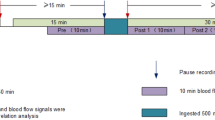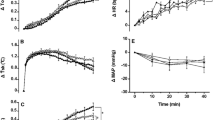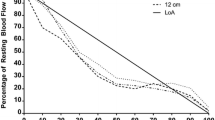Abstract
The purposes of this study were (1) to evaluate changes in blood flow in the brachial artery and basilic vein of the upper arm with a rise in internal temperature during passive heating; and (2) to investigate the contributions of blood velocity and anteroposterior vessel diameter to these blood flow changes. Ten subjects rested in the supine position between a pair of tube-lined sheets. Thermoneutral water was circulated through the tubes to keep a mean skin temperature \( (\ifmmode\expandafter\bar\else\expandafter\=\fi{T}_{{{\text{sk}}}} ) \) of 34–35°C, and then hot water was circulated to maintain \( \ifmmode\expandafter\bar\else\expandafter\=\fi{T}_{{{\text{sk}}}} \) of 37–38°C. The blood velocity and diameter in the brachial artery and basilic vein were continuously monitored by Doppler ultrasound technique and used to calculate blood flow. Blood flow in the brachial artery and basilic vein increased linearly as the oral temperature (T or) rose by ≤0.6°C. The magnitude of the change in blood flow did not differ significantly between the two vessels. In addition, plots of ΔT or versus blood flow yielded slopes that did not differ significantly between the brachial artery and the basilic vein. As T or increased, blood velocity, but not diameter, also increased. In conclusion, blood flow in the brachial artery and the basilic vein increased linearly as the internal temperature variable T or increased ≤0.6°C. In both vessels, the passive heating-induced increases in blood flow resulted primarily from a change in blood velocity, rather than from a change in diameter.


Similar content being viewed by others
References
Abraham P, Leftheriotis G, Desvaux B, Saumet M, Saumet JL (1994a) Diameter and blood velocity changes in the saphenous vein during thermal stress. Eur J Appl Physiol 69:305–308
Abraham P, Leftheriotis G, Desvaux B, Saumet M, Saumet JL (1994b) Venous return in lower limb during heat stress. Am J Physiol Heart Circ Physiol 267:H1337–H1440
Detry JMR, Brengelmann GL, Rowell LB, Wyss C (1972) Skin and muscle components of blood flow in directly heated resting man. J Appl Physiol 32:506–511
Edholm OG, Fox RH, Macpherson RK (1956) The effect of body heating on the circulation in skin and muscle. J Physiol 134:612–619
Eiken O, Kölegård R (2004) Comparison of vascular distensibility in the upper and lower extremity. Acta Physiol Scand 181:281–287
Escourrou P, Freund PR, Rowell LB, Johnson DG (1982) Splanchnic vasoconstriction in heat-stressed men: role of renin-angiotensin system. J Appl Physiol 52:1438–1443
Flemming BP, Lone SP, Nils D (1992) Peripheral and central blood flow in man during cold, thermoneutral, and hot water immersion. Aviat Space Environ Med 63:346–350
Green D, Bilsborough W, Naylor LH, Reed C, Wright J, O’Drixcoll G, Walsh JH (2005) Comparison of forearm blood flow responses to incremental handgrip and cycle ergometer exercise: relative contribution of nitric oxide. J Physiol 562:617–628
Green D, Cheetham C, Mavaddat L, Watts K, Best M, Taylor R, O’Driscoll G (2002a) Effect of lower limb exercise on forearm vascular function: contribution of nitric oxide. Am J Physiol Heart Circ Physiol 283:H899–H907
Green D, Cheetham C, Reed C, Dembo L, O’Driscoll G (2002b) Assessment of brachial artery blood flow across the cardiac cycle: retrograde flows during cycle ergometry. J Appl Physiol 93:361–368
Hashimoto M, Akishita M, Eto M, Ishikawa M, Kozaki K, Toba K, Sagara Y, Taketani Y, Orimo H, Ouchi Y (1995) Modulation of endothelium-dependent flow-mediated dilation of the brachial artery by sex and menstrual cycle. Circulation 92:3431–3435
Joannides R, Costentin A, Iacob M, Compagnon P, Lahary A, Thuillez C (2002) Influence of vascular dimension on gender difference in flow-dependent dilation of peripheral conduit arteries. Am J Physiol Heart Circ Physiol 282:H1262–H1269
Johnson JM, Park MK (1981) Effect of upright exercise on threshold for cutaneous vasodilation and sweating. J Appl Physiol 50:814–818
Johnson JM, Rowell LB, Brengelmann GL (1974) Modification of the skin blood flow-body temperature relationship by upright exercise. J Appl Physiol 37:880–886
Koga S, Poole DC, Shiojiri T, Kondo N, Fukuba Y, Miura A, Barstow TJ (2005) Comparison of oxygen uptake kinetics during knee extension and cycle exercise. Am J Physiol Regul Integr Comp Physiol 288:R212–R220
Koroxenidis GT, Shepherd JT, Marshall RJ (1961) Cardiovascular response to acute heat stress. J Appl Physiol 16:869–872
Kubicek WG, Kottke J, Ramos MU, Patterson RP, Witsoe DA, Labree JW, Remole W, Layman TE, Schoening H, Garamela JT (1974) The minnesota impedance cardiograph—theory and applications. Biomed Eng 9:410–416
Minson CT, Wladkowski SL, Cardell AF, Pawelczyk JA, Kenney WL (1998) Age alters the cardiovascular response to direct passive heating. J Appl Physiol 84:1323–1332
Mullen MJ, Kharbanda RK, Cross J, Donald AE, Taylor M, Vallance P, Deanfield JE, MacMllister RJ (2001) Heterogeneous nature of flow-mediated dilation in human conduit artery in vivo. Circ Res 88:145–151
Nadel ER, Bullard RW, Stolwijk JAJ (1971) Importance of skin temperature in the regulation of sweating. J Appl Physiol 31:80–87
Newcomer SC, Leuenberger UA, Hogeman CS, Handly BD, Proctor DN (2004) Different vasodilator responses of human arms and legs. J Physiol 556:1001–1011
Palmieri EA, Palmieri V, Innelli P, Arezzi E, Ferrara LA, Celentano A, Fazio S (2005) Aerobic exercise performance correlates with post-ischemic flow-mediated dilation of the brachial artery in young healthy men. Eur J Appl Physiol 94:113–117
Roddie IC, Shepherd JT, Whelan RF (1956) Evidence from venous oxygen saturation measurements that the increase in forearm blood flow during body heating is confined to the skin. J Physiol 134:444–459
Roddie IC, Shepherd JT, Whelan RF (1957) The contribution of constrictor and dilator nerves to the skin vasodilatation during body heating. J Physiol 136:489–497
Rowell LB (1986) Thermal stress. In: Human circulation regulation during physical Stress. Oxford University Press, New York, pp 174–212
Rowell LB, Brengelmann GL, Murray JA (1969) Cardiovascular responses to sustained high skin temperature in resting man. J Appl Physiol 27:673–680
Rowell LB, Brengelmann GL, Blackmon JR, Murray JA (1970) Redistribution of blood flow during sustained high skin temperature in resting man. J Appl Physiol 28:415–420
Rowell LB, Detry JMR, Profant DG, Wyss C (1971) Splanchnic vasoconstriction in hyperthermic man – role of falling blood pressure. J Appl Physiol 31:864–869
Shima H, Ohno K, Michi K, Egawa K, Takiguhi R (1996) An anatomical study on the forearm vascular system. J craniomaxillofac Surg 24:293–299
Shima H, Ohno K, Shimizu T, Michi K, Egawa K, Takiguhi R (1992) Anatomical study of the valves of the superficial veins of the forearm. J Craniomaxillofac Surg 20:305–309
Wyss CR, Brengelmann JM, Johnson JM, Rowell LB, Niederberger M (1974) Control of skin blood flow, sweating, and heart rate: role of skin vs. core temperature. J Appl Physiol 36:726–733
Acknowledgments
We thank our volunteer subjects for participating in this study. This study was supported by a Grant-in-Aid for Scientific Research (#16300208) from the Ministry of Education, Science, Sports and Culture of Japan.
Author information
Authors and Affiliations
Corresponding author
Rights and permissions
About this article
Cite this article
Ooue, A., Ichinose-Kuwahara, T., Shamsuddin, A.K.M. et al. Changes in blood flow in a conduit artery and superficial vein of the upper arm during passive heating in humans. Eur J Appl Physiol 101, 97–103 (2007). https://doi.org/10.1007/s00421-007-0478-8
Accepted:
Published:
Issue Date:
DOI: https://doi.org/10.1007/s00421-007-0478-8




